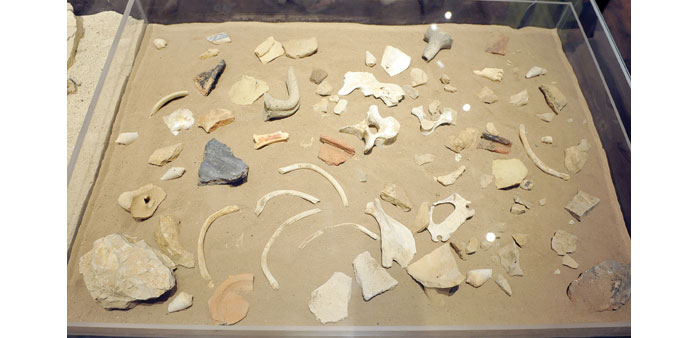By Anand Holla
Excavating and conserving heritage structures across the length and breadth of Qatar may be a painstaking job, but it’s just as intriguing as well.
While the Cultural Heritage team of Qatar Museums (QM) continues to dig its way into archaeological field work on a daily basis, the QM has recently put out information about the good work they do in joining the dots of Qatar’s past, which explains the intriguing bit rather well.
From urban Doha to the coastal regions of the north and the more remote desert areas of the south, the Cultural Heritage division – which covers archaeology, architectural conservation, and cultural tourism – patiently uncovers a lost world.
In the new information that QM shares about its team’s work, we learn about the preventative archaeological activities, cultural heritage database, and conservation projects that they are working on. From Bronze Age settlements to medieval palaces, 19th century forts, villages, towers and mosques, the archaeology and conservation team excavate, restore and protect the parts of Qatar that flourished long ago.
In its blog, the QM shares that the team designs activities at its visitor centres which encourage interaction and get people excited about its projects. “We place special focus on school groups and we partnered with UCL-Qatar to introduce archaeology degree programmes to university students. These will open up possibilities for locals with an interest in the subject to get involved in the safeguarding of Qatar’s cultural heritage,” the QM says, of its team and their efforts at initiating cultural tourism.
Apart from handling heritage sites, the Cultural Heritage team is also involved in activities like rescue and preventive archaeology, which also forms the bulk of their work. Consisting of desktop studies, field surveys, recording of buildings, watching briefs, and trial pitting, the rescue and preventive archaeological works are put in place prior to a development project, because they help understand whether a development project affects heritage assets.
“Developers in Qatar are forced to obtain a No Objection Certificate (NOC) from Qatar Museums during the design phase of their projects, a procedure that enables us to discover, record and study the heritage assets and more importantly, to manage their future protection,” the QM shares.
Wherever they can, the team goes into a breathless pursuit to decode the urban fabric of old Doha – the transition from one and two story houses in the first half of 20th Century to the concrete-and-cement buildings in the 1960s and 1970s, and eventually the tall, ultra-modern concrete-cement-metal-glass high-rises that dot the Doha skyline today. In their project called Mapping Old Doha, the team records the old urban fabric in and around the capital, in a consistent and comprehensive manner.
The QM explains, “Mapping is a recording tool carried out through surveys. Data is gathered on the ground in a systematic, uniform manner according to specific criteria concerning building type, use and structural condition, as well as interior features and decorative elements. The recorded data is entered in a GIS-based database and provide information about the extent of each heritage building within the urban context, its social value, function and its relationship with other buildings.”
“It has already provided initial results in terms of establishing a framework for informed decision-making regarding the interpretation, conservation and rehabilitation and management of heritage assets in old Doha,” the QM adds.
Then, of course, is the old Doha rescue excavation project. As Doha Metro is all set to tie up the entire city with four main lines, one of its stations planned by Qatar Rail covers an area that is at the core of where the city of Doha was founded, some 200 years ago. “Our archaeologists excavated in this area for four months. We worked with the Origins of Doha Project team of UCL-Qatar for part of this work, who helped us to document the evidence of Old Doha and rescue the artefacts found before the area was destructed,” the QM points out.
The Old Palace restoration is an interesting task, too. It was in the early 20th century that Sheikh Abdullah bin Jassim al-Thani’s Old Palace was built. This palace was at the centre of Qatar’s political leadership for around 25 years, serving as residence of the Royal Family and the seat of government. “The palace was converted into the National Museum of Qatar in 1975, which included a Museum of the State, lagoon and marine aquarium. The building won the Agha Khan award for restoration and rehabilitation of Islamic architecture in 1980,” the QM says.
Though it is closed now, the restored Old Palace will be at the heart of the new National Museum of Qatar and its restoration will set a new benchmark for the treatment of historic buildings and architectural conservation, according to the QM.
As for the cultural heritage database known as Qatar Cultural Heritage Information Management System (QCHIMS), it is designed to manage all key datasets in a central, integrated database, easily accessible by all staff and stakeholders, and is fully bilingual (Arabic and English).
The team is as keen to work on several projects with other local organisations, like the Qatar Islamic Archaeology and Heritage Project that aims to investigate, preserve and present Islamic archaeology and the natural heritage of Northern Qatar, and the Wales Qatar Archaeological Project that mainly deals with the research, excavation and surveys of coastal sites in Northern Qatar, such as Rubayqa and Ruwayda.
Other such projects include Qatar National Historic Environment Record, which researches on terrestrial and marine areas of Qatar, and the South Qatar Survey Project, which aims to undertake archaeological surveys and excavations in the southern part of Qatar and train Qatari and German students in archaeological fieldwork.

